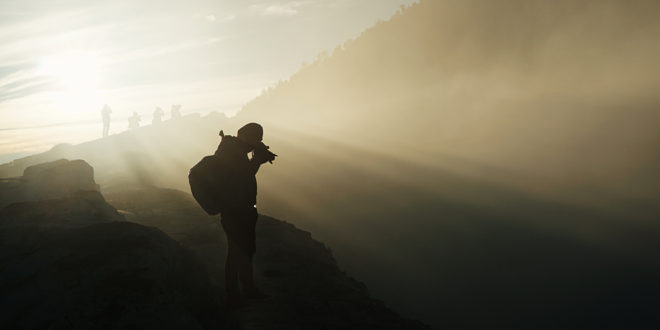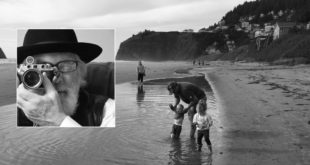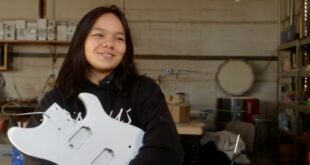We asked Glenn Sackett about his background and interest in photography.
inSpire – Glenn you have developed quite an eye for taking interesting, art quality photographs. When did you first develop this and what keeps you inspired?
Sackett – As a child growing up in the country, I was surrounded by natural beauty. So I’d say God gave me the raw material; then my family gave me the tools. Mom painted landscapes in oil, as did her dad. He was also a photographer, and as the founder of the first Pathfinder club, he enjoyed helping kids discover the wonders of Creation. Dad made sure we always had a subscription to National Geographic and he was always taking me outdoors. Both parents loved nature, stimulated my curiosity and taught me to be a good observer.
Mom put a Kodak Brownie in my hand when I was 6 or 7 years-old. By the summer I turned 8, Granddad saw that my photos were more than snapshots, so he took me into his darkroom, where the magic captured my imagination. He mentored me whenever I visited him (We lived halfway across the country); he also initiated a life-long learning process by introducing me to books by Ansel Adams and other masters of photography. Those summer trips inspired me in another way: my parents would choose a different cross-country route for each trip, so by the time I was 12 I had seen most of the National Parks in the West. My library trips, besides including the latest car magazines, always found me looking at books by great photographers and books about National Parks.
By this time I knew I needed more than a point-and-shoot camera to take the kind of photos I had been studying. I took my life savings downtown and bought my first single lens reflex camera, an Exa (baby Exacta), and started shooting Kodachrome. It really does, as Paul Simon said later in the song “Kodachrome,” give you nice bright colors that far surpassed the prints my friends were shooting.
Two things keep me inspired. The first I realized about the time I shot my 10,000th slide (yes, I had them all numbered, many with notes about exposure details to keep me learning and fine tuning my craft). Why hadn’t I published more than I had? Other folks kept telling me they were good enough, and I certainly had had no trouble getting them on magazine covers when I took the time to offer them. The answer came when I realized this: What I love most about photography is the experience itself. Being in nature, unhurried, carefully observing light and color, flora and fauna, waiting for the right moment to capture something special; I realized this had become a form of meditation, vitally connecting me to creation and the Creator. Such meditative experience can often be recognized by a paradox: a particular moment in time extends into timelessness.
My second inspiration is the result: the “capture and release” of natural beauty that arrests attention and gives one a sense of “being there,” both for me, the one who was there, and for others who were not, except through experiencing the photograph. Richard Nelson Bolles said it this way in What Color is Your Parachute?: “In general there are three parts to our mission in life: ‘To promote good, to oppose evil and to release beauty.'” Our individual particular mission in life is found at the intersection of three things: what God needs done in the world, what the world needs done and the place where our individual talents and gifts meet those needs. For me, photography lives at that intersection. I know that has happened when someone mentally walks right into one of my photographs, becomes engrossed and loses all sense of time in the moment of beauty I experienced when I snapped the shutter.
inSpire – What do like to focus on most? Some photographers shoot urban scenery or portraits, while others zero in on nature.
Sackett – I am inspired and invigorated most in the “natural” world of creation. Sometimes I wonder “Why is there beauty?” God could have made everything work just fine without making it beautiful (think 20th century Eastern Bloc concrete cities). Why were we humans given the capacity to appreciate beauty? Besides the beauty, I’m constantly impressed by all the interdependence of life forms and natural elements. Though I studied for ministry all through school, I was better at science than religion and history, so the roots of my spirituality grow from that soil. It all comes alive for me when I’m photographing nature, so that’s where I go every time I can make time to get outdoors. I always have a camera, from my morning walk/run/bike ride, to a day trip outdoors nearby, to a journey to some far-off place I want to explore. I add a vacation day to every business trip, searching out natural attractions within driving distance of the meeting location; that way I come home inspired, not just “tired and wired.”
In nature I find a paradoxical experience with time. I snap the shutter at a specific moment, yet my photographs often have a sense of timelessness. Timing is everything: I may hike for hours to be at a small reflecting pool at the moment dawn’s first blaze illuminates a mountain peak with its warm light. I may sit as long as it takes, with my camera all set on the tripod, waiting for the right combination of light: a cloud shadow on the waterfall in the foreground while there’s full sunlight on the ridge-line behind at the same time. I will sit quietly with wildlife until they are no longer concerned with my presence, accepting me as part of their world, a fellow traveler and ally rather than a threat. There is timelessness in this waiting: I am “here.” I am where I want to be. There is no “I’d Rather Be….(anything else).” I am fully present. This is an experience of “being” fully in the moment, a foretaste of the experience of eternal life. That’s the sense I seek to convey to others through my photography.
Beauty in the constructed world also engages me. I’ve studied architecture since growing up near Frank Lloyd Wright’s “Talaesin.” This God-given beauty thing can show up anywhere, from an old barn to a cathedral, from the mirrored skin of a corporate headquarters building to an welcoming interior space, from a window-lit bench of old tools to a finished one-off piece of hand-crafted furniture.
People are beautiful, too, especially when they are doing something that completely engages them. It could be work, play or meditation. As with wildlife I’d prefer to become invisible so they are not self-consciously posing for the camera. Recently I have challenged that preference to develop environmental/vocational portraiture, especially to recognize and honor the work of people who express a sense of mission beyond the task or job they do. People are beautiful when they are doing what they are designed to do.
inSpire – Thank you for giving us a glimpse into your world and passion for photography. Keep taking those riveting shots.
This interview was conducted by Rich DuBose, Director of Pacific Union Conference Church Support Services and the inSpire project.
© 2017 - 2024 ASA. All rights reserved. Click here for content usage information.



